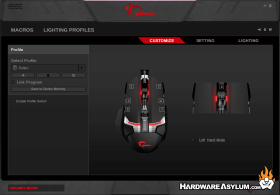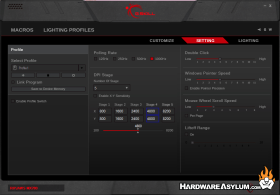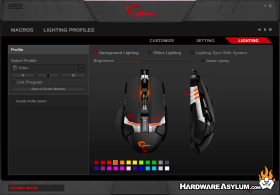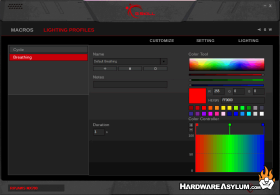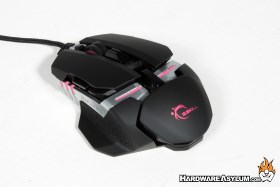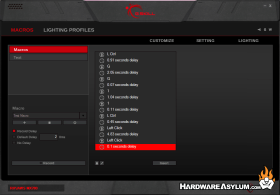G.Skill Ripjaws MX780 Gaming Mouse Review
Author: Darren McCainSoftware
GSkill provides a driver called the Unified Driver system via the website. No driver ships with the MX780. Unified leads me to believe the suite will eventually integrate with more products. As of this review I amusing software version 0.61 and firmware version 16 dated December 14, 2015.
The software is divided into four main sections: Profile Management, Profile Settings, Macros and Lighting Profiles and Additional Settings. Most of the functionality is based on the user profiles and the software defaults you to the Profile customize functionality. Up to 5 profiles can be saved to the onboard 512KB memory and any customization must be assigned to a profile. Profiles can be saved via the import/export functionality. Each of the 8 buttons can also be programmed and saved to the profile.
The Profile Settings menu provides access to the usual settings. Polling DPI Click rates and such can be individually adjusted and saved to a profile. There is a lot to see here. I found the DPI settings felt most comfortable at about 4800 which is lower than my usual favorites. Maybe it’s the smaller size?
Lighting is split across two areas. This was the most frustrating thing to play with initially as areas can be selected individually or in groups. Once I discovered you can select several with a mouse drag, I was off to the races! Lighting can be selected static by area or in the lighting Profiles by effect. Sadly some of the colors look better on the software which seems to be common in some RGB designs. Primary colors are vivid and look great but my matching orange was a bit washed out.
I am always a sucker for breathing effects and can see some perfectionists spending lots of time working on color effects. Very cool!
Here is a quick look at the default red color across all the color zones. It looks even better with the lights down low. I really can’t wait to fire up the matching KM780R Gaming Keyboard at the next LAN.
Macro functionality can be set in two different ways: Keystroke macros and Text macros. If you are looking to set delays or customize using keystrokes within the macro, then use the keystroke macro. If you are looking to set text-only macro, then use the text macro. Macros can also be imported or exported and editing seems intuitive if not revolutionary.

